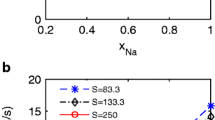Summary
Cationized ferritin (CF) applied intracellularly in squid giant axons bound to the negatively charged sites on the cytoplasmic surface of the axolemma. Under the electron microscope, the distribution of CF was found to be dense and uniform over the axolemmal surface. However, the effect of CF on the membrane excitability was highly specific, the major effect being a prolonging of the inactivation time course of the sodium channel without altering the properties of the potassium channel. The binding of CF did not alter the surface potential related to the membrane excitability. When CF was present intracellularly, the time course of the inactivation was characterized by two time constants (slow and fast). The slow component increased with an increase in CF binding and its time constant had a unique value (26 msec) irrespective of the duration of perfusion and concentration of CF. The concentration of CF at which the half-maximum response occurred was about 150nm. Poly-l-glutamate, charged negatively at neutral pH, removed CF from the axolemma and counteracted the CF effect on the sodium channel, although this poly-acidper se did not affect the membrane excitability. Our results indicate that CF binds electrostatically to the inactivation site of the sodium channel but does not affect the voltage sensor, which is supposed to be located deep in the channel.
Similar content being viewed by others
References
Armstrong, C.M., Bezanilla, F., Rojas, E. 1973. Destruction of sodium conductance inactivation in squid axons perfused with pronase.J. Gen. Physiol. 62:375–391
Baker, P.F., Hodgkin, A.L., Shaw, T.I. 1962. Replacement of the axoplasm of giant nerve fibres with artificial solutions.J. Physiol. (London) 164:330–354
Carbone, E., Fioravanti, R., Prestipino, G., Wanke, E. 1978. Action of extracellular pH on Na+ and K+ membrane currents in the giant axon ofLoligo vulgaris.J. Membrane Biol. 43:295–315
Carbone, E., Testa, P.L., Wanke, E. 1981. Intercellular pH and ionic channels in theLoligo vulgaris giant axon.Biophys. J. 35:393–413
Chandler, W.K., Hodgkin, A.L., Meves, H. 1965. The effect of changing the internal solution on sodium inactivation and related phenomena in giant axons.J. Physiol. (London) 180:821–836
Clegg, G.A., Fitton, J.E., Harrison, P.M., Treffry, A. 1980. Ferritin: Molecular structure and iron-storage mechanisms.Prog. Biophys. Mol. Biol. 36:56–86
Danon, D., Goldstein, L., Marikovsky, Y., Skutelsky, E. 1972. Use of cationized ferritin as a label of negative charges on cell surfaces.J. Ultrastruct. Res. 38:500–510
D'Arrigo, J.S. 1973. Possible screening of surface charges on crayfish axons by polyvalent metal ions.J. Physiol. (London) 231:117–128
Drouin, H., Neumcke, B. 1974. Specific and unspecific charges at the sodium channels of the nerve membrane.Pfluegers Arch. 351:207–229
Fohlmeister, J.F., Adelman, W.J., Jr. 1982. Periaxonal surface calcium binding and distribution of charge on the faces of squid axon potassium channel molecules.J. Membrane Biol. 70:115–123
Frace, A.M., Poznansky, M., Eaton, D.C., Brodwick, M.S. 1985. Effects of phospholipid headgroup modification in voltage clamped squid axon.Biophys. J. 47:440a
Frankenhaeuser, B., Hodgkin, A.L. 1957. The action of calcium on the electrical properties of squid axons.J. Physiol. (London) 137:218–244
Furuya, K., Furuya, S., Yamagishi, S. 1983. Developmental time courses of Na and Ca spikes in neuroblastoma x glioma hybrid cells.Dev. Brain Res. 11:229–234
Gilbert, D.L., Ehrenstein, G. 1969. Effect of divalent cations on potassium conductance of squid axons: Determination of surface charge.Biophys. J. 9:447–463
Hahin, R., Campbell, D.T. 1983. Simple shifts in the voltage dependence of sodium channel gating caused by divalent cations.J. Gen Physiol. 82:785–805
Hille, B. 1968. Charges and potentials at the nerve surface. Divalent ions and pH.J. Gen. Physiol. 51:221–236
Hille, B., Woodhull, A. M., Shapiro, B.I. 1975. Negative surface charge near sodium channels of nerve: Divalent ions, monovalent ion, and pH.Philos. Trans. R. Soc. London B 270:301–318
Hirano, H., Nishiyama, F., Furuya, K., Yamagishi, S. 1983. Binding of cationized ferritin on the cytoplasmic surface of the axolemma and its effect on the membrane excitation.Proc. Jpn. Acad. B59:140–143
Kukita, F. 1982. Properties of sodium and potassium channels of the squid giant axon far below 0°C.J. Membrane Biol. 68:151–160
Moore, J.W., Narahashi, T., Ulbricht, W. 1964. Sodium conductance shift in an axon internally perfused with a sucrose and low-potassium solution.J. Physiol. (London) 172:163–172
Mozhayeva, G.N., Naumov, A.P. 1970. Effect of surface charge on the steady-state potassium conductance of nodal membrane.Nature (London) 228:164–165
Okamoto, H., Takahashi, K., Yamashita, N. 1977. One-to-one binding of a purified scorption toxin to Na channels.Nature (London) 266:465–468
Oxford, G.S., Wu, C.H., Narahashi, T. 1978. Removal of sodium channel inactivation in squid giant axons byN-bromoacetamide.J. Gen. Physiol. 71:227–247
Rennke, H.G., Cotran, R.S., Venkatachalam, M.A. 1975. Role of molecular charge in glomerular permeability. Tracer studies with cationized ferritins.J. Cell Biol. 67:638–646
Takata, K., Nishiyama, F., Hirano, H. 1981. Double labeling study of anionic sites and concanavalin A binding sites in monkey macrophages.J. Histochem. Cytochem. 29:858–863
Takenaka, T., Yamagishi, S. 1969. Morphology and electrophysiological properties of squid giant axons perfused intracellularly with protease solution.J. Gen. Physiol. 53:81–96
Tasaki, I., Watanabe, A., Takenaka, T. 1962. Resting and action potential of intracellularly perfused squid giant axon.Proc. Natl. Acad. Sci. USA 48:1177–1184
Wang, G.K. 1984. Irreversible modification of sodium channel inactivation in toad myelinated nerve fibres by the oxidant chloramine-T.J. Physiol. (London) 346:127–141
Wanke, E., Carbone, E., Testa, P.L. 1980. The sodium channel and intracellular H+ blockage in squid axons.Nature (London) 287:62–63
Author information
Authors and Affiliations
Rights and permissions
About this article
Cite this article
Furuya, K., Hirano, H., Nishiyama, F. et al. Intracellular binding of cationized ferritin prolongs the time course of sodium channel inactivation in squid giant axons. J. Membrain Biol. 89, 75–83 (1986). https://doi.org/10.1007/BF01870897
Received:
Revised:
Issue Date:
DOI: https://doi.org/10.1007/BF01870897



